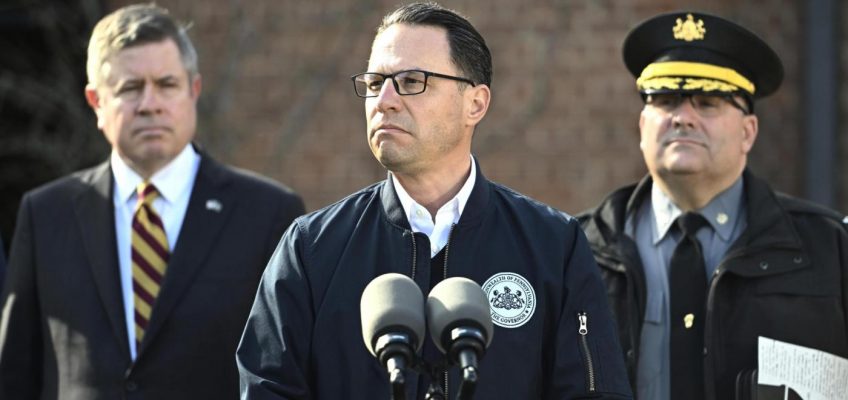Armed with nothing more than notecards held in shaking hands and a box of tissues on the courtroom podium, Christian Glass’ family stood before a Clear Creek County judge and pleaded for the deputy who killed the 22-year-old to receive the maximum sentence.
“You going to prison isn’t going to make you a decent person, you going to prison isn’t going to bring back our son,” said Sally Glass, Christian’s mother, addressing the table where former Clear Creek County sheriff’s deputy Andrew Buen sat. “…But you’ve done so much damage, and you must not be able to get away with it.”
Sally Glass choked on her words throughout her speech to the judge during the Monday morning sentencing hearing, fighting back tears. At times, she stopped speaking completely to breathe deeply and compose herself, allowing silence to fill the courtroom.
Buen faced up to three years in prison after he was convicted in February of criminally negligent homicide in the 2022 killing of Christian Glass. He was also convicted of reckless endangerment, a misdemeanor typically punished by no more than 120 days in jail, in an initial jury trial that ended with the jury deadlocked on a murder charge.
During the Monday morning hearing, Clear Creek County District Court Judge Catherine Cheroutes granted Buen the maximum possible sentence: three years in the Colorado Department of Corrections for the homicide charge and 120 days in jail for the reckless endangerment charge. The sentences will be served concurrently.
“Mr. Buen killed Christian Glass, and that deserves punishment,” Cheroutes said. “There’s no question in my mind that that is appropriate. … This was about power. This wasn’t a mistake.”
Cheroutes said the sentence needed to address “the needs of the victims and the community” while also serving as an example and promoting respect for the law.
Still, the maximum sentence doesn’t feel like enough and pales in comparison to the years Buen stole from his 22-year-old son, Christian’s father, Simon Glass, said.
“What a waste, what a terrible waste,” Simon Glass said.
He said the family is still struggling to come to terms with his son’s death and that talking about his son in the past tense feels “completely alien, like someone else is speaking.”
Simon Glass also struggled to complete his testimony before Cheroutes during the sentencing hearing. He said all of his once-happy memories of his son had been infused with pain — not just from the shooting, but from the drawn-out legal process and multiple trials.
“This entire trial has been incredibly difficult for all of us,” said Katie Glass, Christian’s sister. “I am not the same person I was before. I have anxiety attacks, I have depression, I can’t live my life like I used to be able to. And I just miss him.”
Buen shot and killed Christian Glass on June 10, 2022, after the 22-year-old called 911 for help when his car got stuck on a rock in Clear Creek County near Silver Plume, small town along Interstate 70 west of Denver. Glass, who had marijuana and amphetamine in his system, was experiencing a mental health crisis and told dispatchers he was afraid of “skinwalkers” and people chasing him.
“He died terrified, in pain and all alone,” Katie Glass said. “That’s what hurts me the most.”
Seven law enforcement officers responded to Glass’ 911 call and spent more than an hour trying to coax Glass out of the car while he was experiencing delusions and paranoia. Eventually, Buen decided to break Glass’ window and pull him from the vehicle.
When officers broke the window, Glass grabbed a knife and officers fired a Taser at him and shot him with beanbags in an attempt to force him to drop it. Instead, Glass twisted in the driver’s seat and thrust the knife toward an officer standing next to the shattered window behind him, prompting Buen to shoot Glass five times. Glass then stabbed himself several times.
A separate grand jury investigation into the incident in 2022 found Glass committed no crime, acted in panic and self-defense before he was killed and never actually came close to stabbing the officers. The involved law enforcement agencies agreed to a $19 million settlement with Glass’ parents in May.
Buen was fired after he was indicted.
“Christian deserved better, you all deserved better,” Buen said during the sentencing hearing, standing before the court in his orange prison jumpsuit. “This is something I have to live with.”
He said there were a million things he could have done better that night and he wishes that he had done differently.
Simon Glass called out the grief displayed by Buen, his attorney and his supporters as performative and said the former deputy has continually shown “a complete lack of remorse throughout the trial.” Buen and his attorney insisted the regret was genuine.
He said every time he speaks with his family, they talk about their favorite memories and time together.
“I can’t imagine sharing those moments and having the person that they’re about be gone,” Buen said.
Buen’s sister, Jennifer, said she’s had to deal with the “unbearable pain of watching your brother slip away.”
She and her daughter, Abigail, told the judge that Andrew Buen changed after the 2022 shooting. They said he was “beyond broken and hurt” and became distanced.
Buen’s mother and close friends also testified on behalf of the ex-deputy, asking the court for “mercy.”
Judge Cheroutes said she truly believed the group’s statements about Buen, that he is a kind, gentle and loyal person, but she said that all changed once in uniform and armed.
She said law enforcement officers need to remember that they are public servants and “their duty” is to not violate their oath to serve and protect.
“And that is exactly what happened in this case,” she said.
Andrew Buen’s supervisor, former Clear Creek County Sheriff’s Sgt. Kyle Gould, was not there during the incident but gave Buen permission to break into Glass’s car. Gould pleaded guilty to failing to intervene in the excessive force of another officer in 2023 and was sentenced to two years of probation.
An additional four law enforcement officers face charges of failing to intervene in the excessive force of another officer; their criminal cases are pending.




